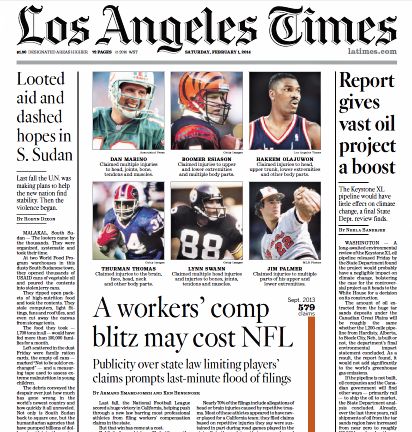The very lengthy first story from the AP in its lead paragraph tells us (emphasis added):
Amid severe drought conditions, California officials announced Friday they won't send any water from the state's vast reservoir system to local agencies beginning this spring, an unprecedented move that affects drinking water supplies for 25 million people and irrigation for 1 million acres of farmland.
The second story from the Sacramento Bee in its lead paragraph tells us:
State officials announced Friday that 29 water agencies serving 25 million people across California can expect “zero” water deliveries from the State Water Project this summer because of the worsening drought.
The third story from the LA Times in its lead paragraph tells us:
Officials Friday said that for the first time ever, the State Water Project that helps supply a majority of Californians may be unable to make any deliveries except to maintain public health and safety.
Of course, the LA Times story lead is accurate because if it rains 40" in Northern and Central California over the next few months things will be swell. Golly gee, don't alarm all those with those Southern California lawns.
However, the real impact is only now being alluded to. While all the articles offer some agriculture facts, this statement in the AP article tells what it means beyond the rest of us facing water shortages simply being inconvenienced:
The timing for of Friday's historic announcement was important: State water officials typically announce they are raising the water allotment on Feb. 1, but this year's winter has been so dry they wanted to ensure they could keep the remaining water behind the dams. The announcement also will give farmers more time to determine what crops they will plant this year and in what quantities.
Farmers and ranchers throughout the state already have felt the drought's impact, tearing out orchards, fallowing fields and trucking in alfalfa to feed cattle on withered range land.
Down further in the Bee's article:
State and federal officials announced that starting today, water diversions from the Delta, a crucial wildlife habitat and California’s largest freshwater source, will be minimized to serve only urban areas and health and safety purposes. No water will be diverted for farms.
In addition, some 5,800 junior water rights holders across the state – mainly farms – will receive notices next week that they must reduce their water diversions from streams. And water quality rules in the Delta will be adjusted, which will increase salinity for some water users in the region and may affect wildlife.
The prices of California agricultural products could skyrocket. And that isn't just avocados for your Superbowl party guacamole or lemon juice for lemonade.
The California rice industry annually produces more than 2 million tons of rice. An average of 60 percent of the annual rice crop goes on America's dinner table, into sushi restaurants, made into beer, rice mixes and even pet food. Exports markets are also a key destination for California rice. Countries such as Japan, Korea, Taiwan and Turkey account for 40 percent of annual production.
But the Times tells this to the millions of readers living in LA LA Land:
But the practical effect is less stark because most water districts have other sources, such as local storage and groundwater, to turn to. Officials stressed that the cut did not mean faucets would run dry.
The Metropolitan Water District of Southern California, the state project's largest customer, has said it has enough supplies in reserve to get the Southland through this year without mandatory rationing.
Now on to today's above-the-fold front page stories:

Of course a story on the problems of the NFL is what's important to most California Southlanders. California farmers are tearing out crops as Southlanders ask "Dear, what's the lawn watering index on the MWD web site" to figure out their frequency of lawn watering (click the index below if you don't believe it):


No comments:
Post a Comment